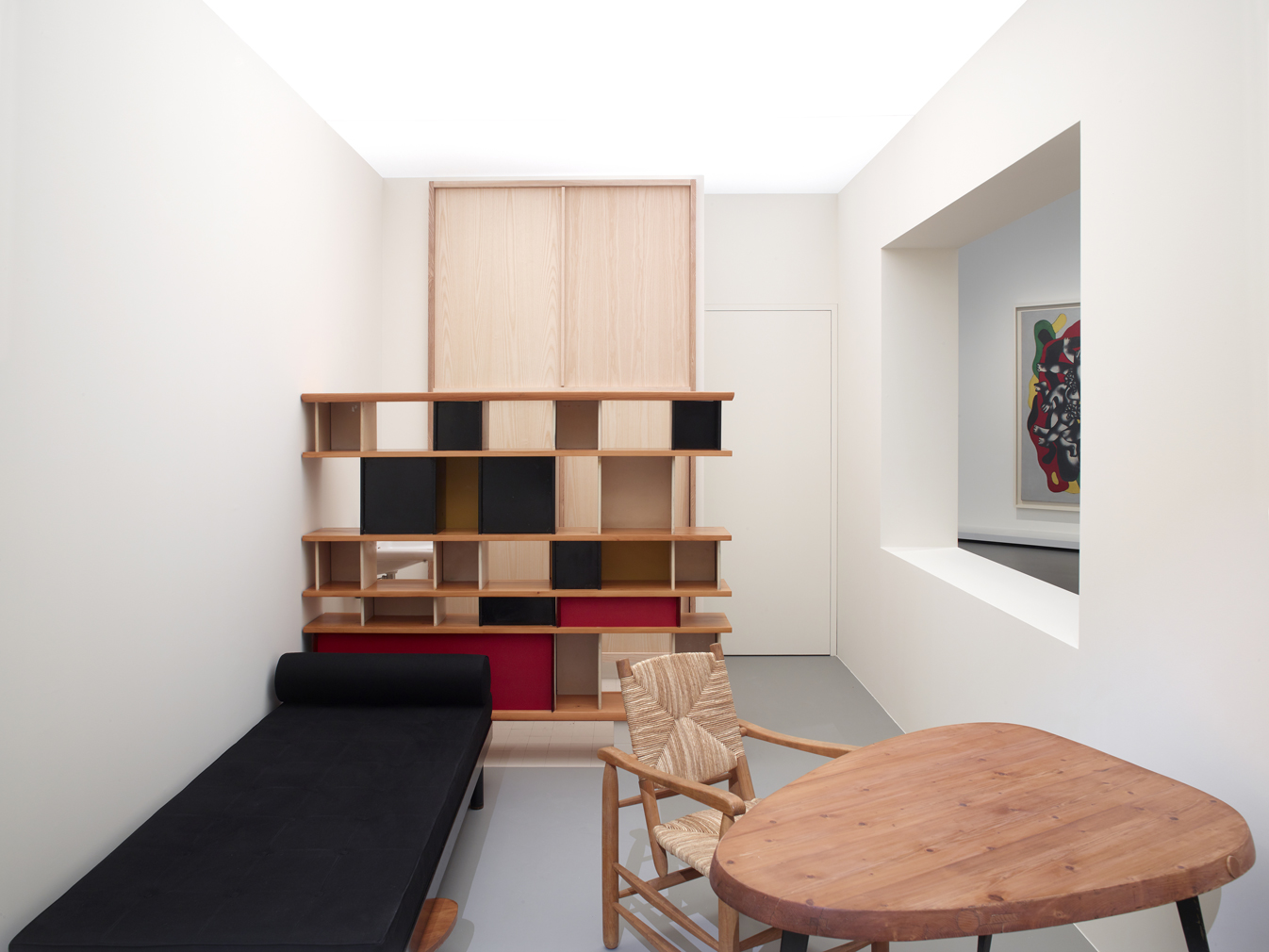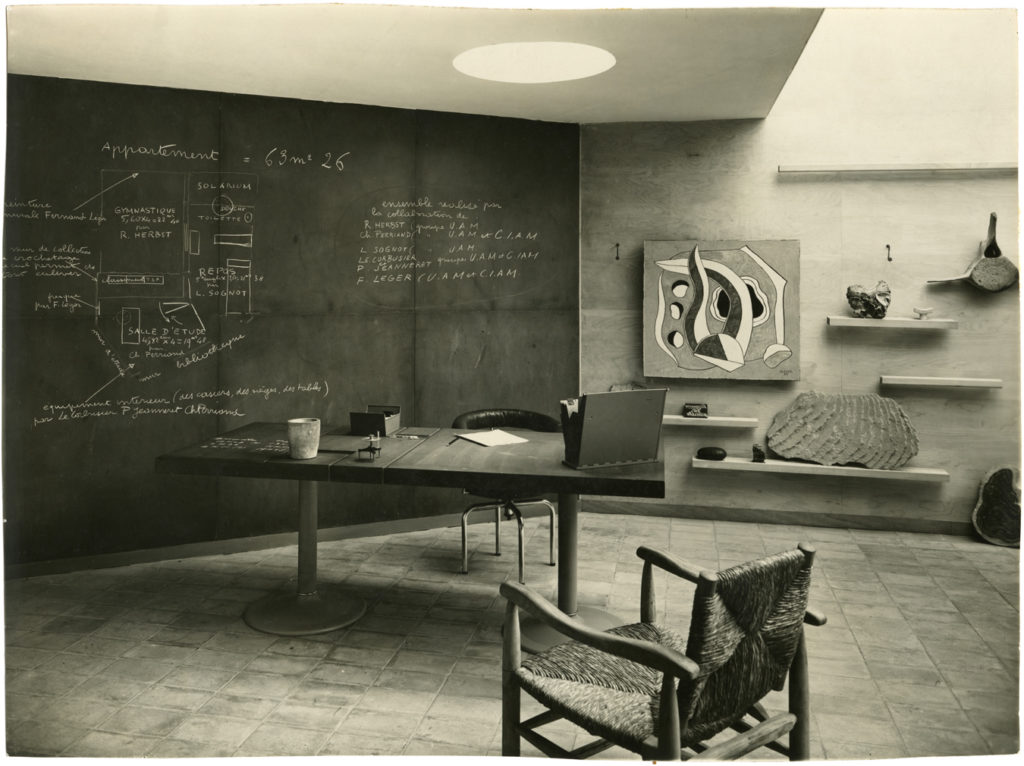Charlotte Perriand: Inventing a New World is the first exhibition in the Fondation Louis Vuitton’s history dedicated to a single artist. The Frank Gehry-designed museum has given over its four floors and eleven galleries, even the outdoor water feature, to detailed reconstructions of Charlotte Perriand’s revolutionary vision for the ‘art de vivre’ (art of dwelling) that continues to reverberate through contemporary architecture and design today.

Born in 1903, Perriand began working in the 1920s and continued up to her death in 1999, her life stretching almost the entirety of the 20th century and interlacing with its most important cultural figures. The exhibition places her work in the context of the politics, art and ideas that were percolating at the time, and includes design by Le Corbusier, Pierre Jeanneret and Jean Prouvé, paintings by Picasso and Fernand Leger, sculptures by Alexander Calder and lights by Isamu Noguchi.
It is the reconstructions in this dazzling show that bring Perriand’s ideas most powerfully to life, enabling us to literally step inside her vision for modern living. Here we explore five of them, from the room that drew the world’s attention in 1929 to the last structure she ever worked on.

Un equipement interieur d’une habitation, Salon d’Automne, Paris, 1929
Having applied to work for Le Corbusier and been rejected with the infamous line, ‘We don’t embroider cushions here’, Perriand managed to capture his attention and a job offer with her ‘Bar sous le toit’ at the 1927 Salon d’Automne. Two years later, she was back at the Salon, this time flanked by Corb and his cousin and collaborator Jeanneret, presenting Un equipement interieur d’une habitation. The apartment was a masterclass in open plan living and the radical use of space. It exchanged walls for functional partitions that doubled as storage, scandalised visitors with its visible washing facilities and presented the ‘furniture classics’ – the swivel chair, the Grand Confort armchair and the chaise longue – that would come to define Perriand’s legacy.
Photography: FLC / Adagp, Paris 2019 (c) Adagp, paris 2019. (c) Jean Collas / AChP

Maison du jeune homme, Exposition Universelle, Brussels, 1935
In 1930, Perriand met the artist Fernand Legér and began a ‘tremendous friendship’ that would span multiple projects, extend into political activism and last until Legér’s death in 1955. Maison du jeane homme represented the friends’ shared belief that creative individualism must be overridden in favour of interdisciplinary collaboration between architects, furniture designers and artists. The space that emerges is similarly flexible, an elegant office cum sports arena that is watched over by a huge original Legér, long presumed lost, which was tracked down by the curators for the exhibition. Interdisciplinary in its inception, the design also demonstrates Perriand’s personal evolution, softening the edges of the mechanical emphasis of 1929 to incorporate natural elements and vernacular craftsmanship.
Photography: (c) Adagp, Paris 2019 (c) C. Vanderberghe/AChP

Refuge Tonneau, 1938 (realised in 2010)
A keen skier, Perriand would often head to the mountains to escape the city, and she believed profoundly in the positive impact of the natural world on the urban dweller. She was environmentally engaged, trying to work out solutions to the question of how to bring large groups in and out of the countryside without leaving a trail of destruction. Her pioneering experiments with prefabricated cabins created lightweight structures that could be easily erected and dismantled and house large numbers of individuals in compact comfort. Most of these prototypes remained unrealised in her lifetime, but they show the early hallmarks of the elegance, environmental sensitivity and economy of space she would later demonstrate as lead architect on the Les Arcs ski resort.
Photography: (c) ADAGP, Paris 2019 (c) AChP

Maison de la Tunisie, Cité Universitaire in Paris, 1952
Commissioned as one of a group of architects and artisans to design furniture and fittings for Jean Sebag’s building for Tunisian students, Perriand was given 39 tiny bedrooms and a strict budget to work with, resulting in stark yet highly efficient design. Her contractual obligation with Atelier Jean Prouvé to use sheet metal prompted her to update her signature sliding shelf units from wood to folded metal, creating polychromatic bookshelves that have become design icons.
Photography: (c) Adagp, Paris 2019 (c) Karquel/AChp

Tea House in the UNESCO gardens, Cultural Festival of Japan in Paris, 1993
In 1940, Charlotte Perriand was invited to Japan as an official advisor to the Ministry of Trade and Industry, to find the best in Japanese crafts and how they could be exported to the rest of the world. It was a strange time for Perriand, as Japan joined the Axis powers soon after her arrival and she was subsequently forced into exile in Vietnam, not returning to France until 1946. However, her designs at this time and onwards demonstrates that the design philosophy of Japan, the emphasis on artisanal products and use of natural materials profoundly impacted her. For the UNESCO commission in 1993, she built an ephemeral area surrounded by bamboo forest, where, she wrote ‘people could meditate and dream about a new golden age, a place humming with cultural exchange, as well as diversity and universality.’ It says so much about Perriand that even aged 91, having lived across the 20th century, she was building structures that looked and spoke to the future, not the past.
Photography: (c) Pernette Perriand-Barsac, Jacques Barsac / AChP

















